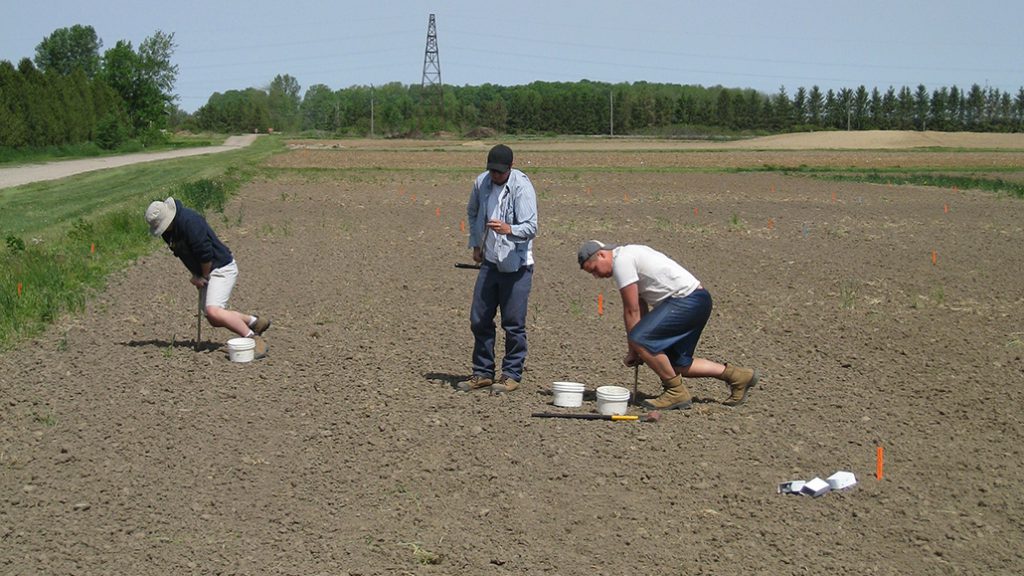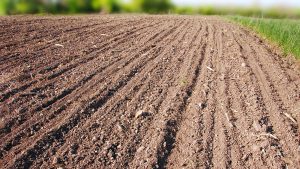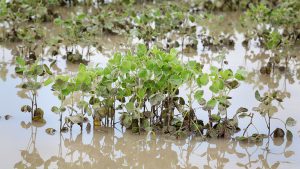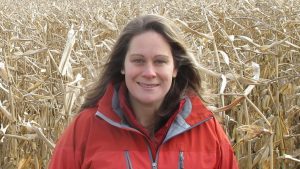The next frontier
SOIL SCIENCE.

THE RELATIONSHIP BETWEEN agriculture and food is a natural one — at least for producers, who nurture it daily.
But the agri-food connection is increasingly becoming a “eureka moment” for the public, too. People are waking up to the realization that agriculture precedes food, and that what they see on their plate comes from complex agri-food systems. As they dig deeper into food production, they’re realizing these agri-food systems depend to a great degree on soil health and preservation.
That’s promoting a new public interest and fascination with soil, says Dr. Laura Van Eerd, who leads the sustainable soil management graduate research program at the University of Guelph Ridgetown Campus. She says the ball really got rolling when the United Nations declared 2015 the International Year of Soil. Initiatives such as World Soil Day, which had been around since the early 2000s, gained momentum. Soil started to become more a part of the conversation. Lately, that conversation contains some exclamation marks.
People see dramatic examples of soil erosion and mismanagement all around them. They see violent images of earth sliding down gullies or mountainsides, washing into lakes, seas, and oceans. They see good farmland getting paved over, or blowing away in dust storms. All this serves to pique their interest, at the very least. However, once they scratch the surface, they also see farmers trying to nurture the soil, conserve it, and manage it.
They see grassroots initiatives such as the Ontario Soil and Crop Improvement Association (OSCIA) and the Ontario Soil Network, farmer-led extension aimed at increasing soil-building best management practices such as cover crops, minimum tillage, and soil amendments. As a result, they’re coming to understand soil is the most fundamental element of the agri-food system. They want to get involved and know more.
‘They’ also includes industry — for example, seed companies, crop protection companies, and other input suppliers aiming at ever-higher yields.
“Three-hundred bushel per acre corn isn’t going to come from a jug or a bag,” says Van Eerd. “These kinds of yields will require years of investing in soil management.”
To her, all this makes soil science ‘the next frontier’.
LONG-TERM RESEARCH
Frontiers are rife with challenges and opportunities that require long-term approaches, which is how Van Eerd fashions her soil science research program. At Ridgetown, she oversees a continuous two-acre soil health research plot with her crew of three graduate students, five undergraduate students, and a field technician.
That plot has been active since 2007. It’s one of only a dozen long-term cover crop trials in North America that compare side-by-side soil management and plant production.
Over this time, she’s had some amazing results.
With support from Grain Farmers of Ontario, the Ontario Processing Vegetable Growers, and the Ontario Ministry of Agriculture, Food and Rural Affairs, Van Eerd and her crew have planted side-by-side cover crop plots 143 times, in grain cropping systems and processing vegetable systems. And 141 times, the cover crop plots have either produced comparable or superior yields compared to plots without a cover crop.
“These figures are my ‘eureka moments’,” she says. “Soil management is long-term, but we’re showing it doesn’t take a lifetime to see results.”
Van Eerd, who also serves as the research program director of the environmental sustainability theme of the Ontario Agri-Food Innovation Alliance Research Program, is seeing her research program grow even further.
In 2018, she became part of a North America-wide initiative called the Soil Health Institute, dedicated to long-term soil health evaluation. Researchers in Canada, the U.S., and Mexico look at 30 soil health indicators and share results that they hope will benefit producers throughout their network.
As well, she was one of three research recipients of a $500,000 donation to the University of Guelph to support soil health outreach in Ontario.
All this excitement about soil science means more graduate student opportunities and more jobs. Van Eerd’s program exposes students to a unique blend of both soil and plant science. That’s led graduates from her program and other agriculture programs at the University of Guelph to jobs in a variety of fields in government, academia, and industry.
OPPORTUNITIES
For example, self-described “soil nerd” Aaron Breimer is general manager of Veritas Farm Business Management in Chatham. He graduated from the University of Guelph in 2001 with an agriculture degree.
“When it comes to an agronomic crop plan, the soil is the foundation for everything else we want to implement and achieve,” says Breimer. “I believe that every farm operation, farm field, and management zone within a field is unique. To me this means that every crop plan has a unique foundation that comes from researching the uniqueness of that specific soil.”
He believes soil science has very specific applications related to profitability. “Yield is limited by whatever nutrient or soil characteristic is in the tightest supply for the crop,” he says. “In other words, all things being equal when it comes to weather, soil science is the limiting factor to increase yields.”
Add in the complexities involved with soil science — which Breimer describes as physical properties, chemical make-up, and biological processes — and every soil test becomes its own unique mystery.
“Trying to unlock the mystery is a great challenge, and cracking those challenges is incredibly rewarding,” he says.
Another example of a student who came to be motivated by soil science is Laura Biancolin, who graduated from the University of Guelph in 2016. She now works as a programs analyst for the OSCIA.
Soil became a big part of her academic life in a fourth-year project in university, analyzing two funding models used to support the adoption of practices that reduced phosphorus losses into drains and creeks.
“It opened my eyes to the multitude of research projects, grant programs, and pilot projects in southern Ontario, all with the goal of reducing nutrient losses through improved soil health,” she says. “The project introduced me to the farmers that are self-starters, take risks, and try out practices with the end goal of creating a system that is economically and environmentally sustainable.”
Biancolin thinks there’s a huge role for communicating about soil — the impact farmers can have on it, and the impact of soil organic matter and soil structure on soil fertility, nutrient cycling, erosion and compaction, and resilience to climatic variables.
“I believe more people would be drawn to soil science if they understood its significance and the amount of time it takes to build organic matter and improve soil structure,” she says.
She encourages students interested in a soil science career to make connections: go on farm tours, talk to neighbours, talk to local associations and networks, talk to the Ridgetown researchers and Ontario Ministry of Agriculture, Food and Rural Affairs extension staff, she suggests.
“The soil world is small and welcoming,” she says, “and the opportunities and directions are endless.”
University of Guelph plant agriculture master’s student Cameron Ogilvie has found soil health is vital no matter where on this planet you farm, or how much land you have, from knowledge he gleaned abroad in Haiti.
“I traveled there for some service projects and witnessed a lot of deforestation and soil degradation, worsened by poverty and trade embargos,” he says. “I realized then the importance of soil systems for subsistence farmers. If you can’t afford external inputs such as synthetic fertilizers, pesticides, you are left to depend on a healthy soil system.”
At Guelph, Ogilvie studies cover crops’ effects on soil physical properties and soil water dynamics. He’s intrigued by soil-related questions, such as: What comprises thriving soil? What untapped potential do soils have to boost agroecosystem productivity? How much can a healthy soil reduce dependence on external inputs? How much can soils be managed to suppress disease and weed populations? How much can soils be managed to improve crop water supply? Can better soil management increase profitability?
To him, all this makes soil science challenging, interesting, and rewarding.
“Agronomy would be a simple science if soil wasn’t part of the equation,” he says. “It’s the ‘black box’ of agroecosystems.”
Van Eerd says these kinds of questions show the potential that soil science offers.
“Everyone in agriculture is looking for good people to hire and there are many jobs for undergraduates, so they may be less likely to go for a master’s or doctorate,” says Van Eerd. “But all around, the need for soil research and conservation is being emphasized. We’d like students to consider graduate opportunities in soil science. It’s the next frontier.” •
| WHAT YOU NEED TO KNOW • Van Eerd oversees a continuous two-acre soil health research plot with her crew of three graduate students, five undergraduate students, and a field technician. • In 2018, Van Eerd became part of a North America-wide initiative called the Soil Health Institute, dedicated to long-term soil health evaluation. • Graduates from Van Eerd’s program and other agriculture programs at the University of Guelph hold jobs in a variety of fields in government, academia, and industry. • This article features a researcher whose work is funded by Grain Farmers of Ontario. |

























